Kuih Rose (or kuih ros) is a crunchy cookie that looks like a flower and is a popular festive treat in Singapore, Malaysia and Indonesia.
Estimated reading time: 11 minutes

Kuih Rose
Let’s look at the name first, shall we?
If you’ve read my other festive recipes, you’ll know that there is no direct translation for the word kuih.
- it’s pronounced coo – way, but the emphasis is on the second syllable. So it’s a short and fast coo, with a k sound.
- there is no direct translation for this Malay word, kue in Indonesian.
It refers to baked or fried goods like cookies, tea time treats and certain snacks.
But not cakes (which is kek).
The plural is kuih-muih, referring to a variety.
And just out of interest, as I love languages, the old spelling (when I was in school) was kueh.
Now that we know how to say it and what it means, let’s look at the other names that kuih rose is known as in Singapore, Malaysia, Indonesia and Brunei.
- kuih loyang – because it uses a mould which is called loyang in Malay and Indonesian.
- kembang goyang in Indonesia, because we shake the mould (goyang) to release the cookie, which resembles a flower (kembang). Fyi, bunga is another name for flower.
- kuih goyang – reason above
- flower cookies
- beehive cookies – as the pattern resembles the pattern on a beehive
Rosette Cookies
Kuih rose, or rose cookies, are found all over the world, with variations on the ingredients used. But they all use the same kind of mould, iron or brass flower attached to a long handle, as you can see in the image.
Rosette cookies are thought to have originated in Scandinavia, and are a traditional treat at Christmas time. You will find them in Europe, throughout Asia, the Middle East and in North Africa. But those recipes you’ll find on LinsFood and my latest blog, Middle Eastern Recipes!
Today, we shall focus on kuih rose the way it’s made in Singapore and Malaysia (and Indonesia) for our festive holidays.

Kuih Rose Recipe
And for all Malay speakers, that’s resepi kuih rose.
Kuih Rose are very, very easy to make at home, requiring only a few ingredients. The traditional kuih rose are made with just rice flour, giving a very crispy end result. Sometimes, I add a pinch of baking powder to create a slightly lighter cookie.
For this reason, some people will add a touch of cornflour (cornstarch in the US) while others use a little all purpose flour. It’s all a matter of preference. However, unlike its European counterpart, the South East Asian rosette cookies are definitely rice flour based.
To make them, this is what we’ll be doing:
- Lightly whisk the egg and sugar with a manual whisk or fork.
- Whisk in coconut milk, just to mix.
- Add in the flour and salt to form a batter, and leave to rest for 10 minutes. There is no need to strain your batter as all other food sites tell you to. Any tiny lumps will fall apart during resting time.
- Heat the oil in a wok on medium heat, then heat the mould in this hot oil while you stir your batter.
- Shake the mould to remove excess oil, then dip into the batter, almost all the way. DO NOT submerge the mould, the top wants to be clear of any batter, see image.
- Dip this batter covered mould into your hot oil and count to 10. Gently shake the mould, and your kuih rose will just glide off it.
- As soon as your rosette cookie is a light golden brown, take it out and place on a plate lined with kitchen paper. The cookie will continue browning for a few seconds, so take it out while it’s still a light brown in colour.
If this is your first time, it’ll take a 2-3 cookies before you get the hang of it – don’t fret! - Cool to room temperature and store in an airtight container for up to 2 weeks. It will go 3 weeks, but is best in the first 2.
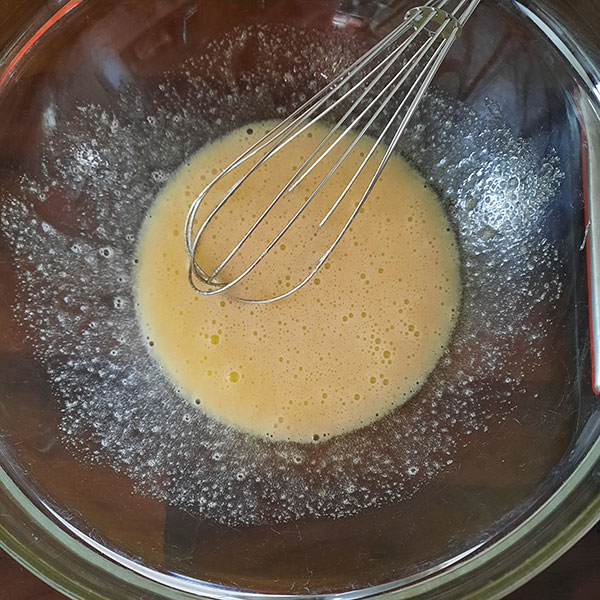
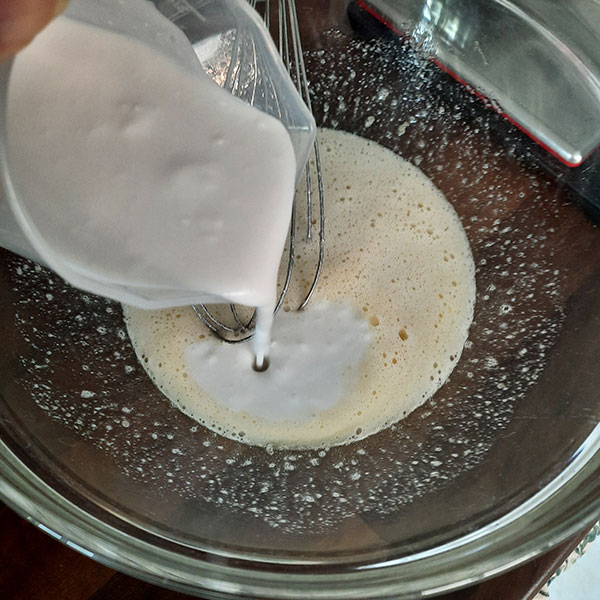


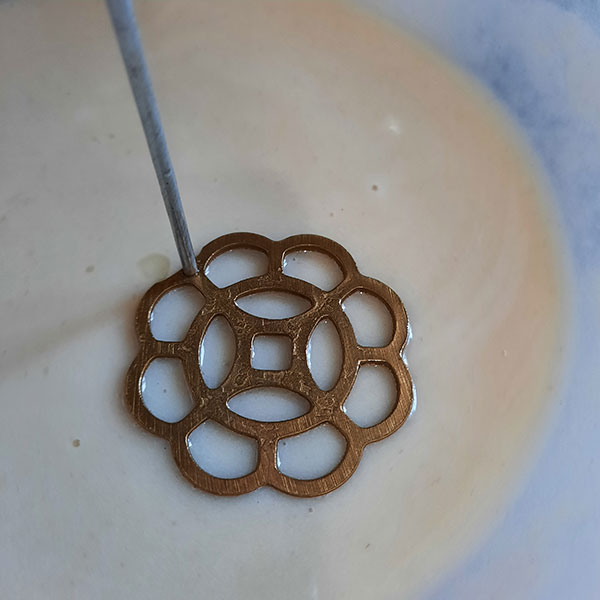
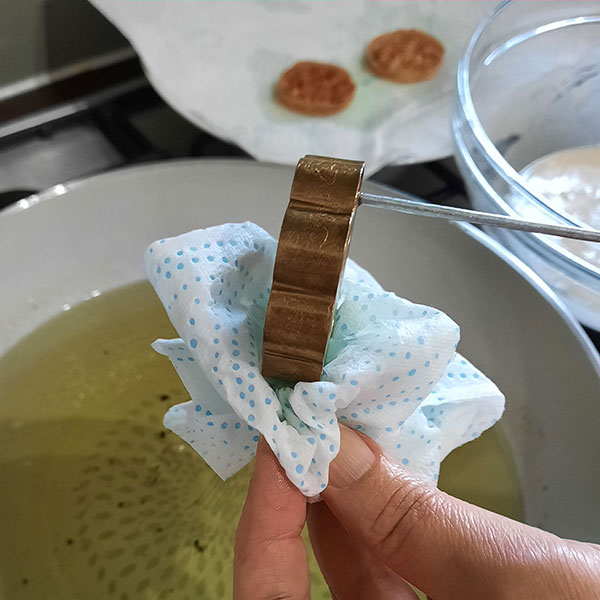
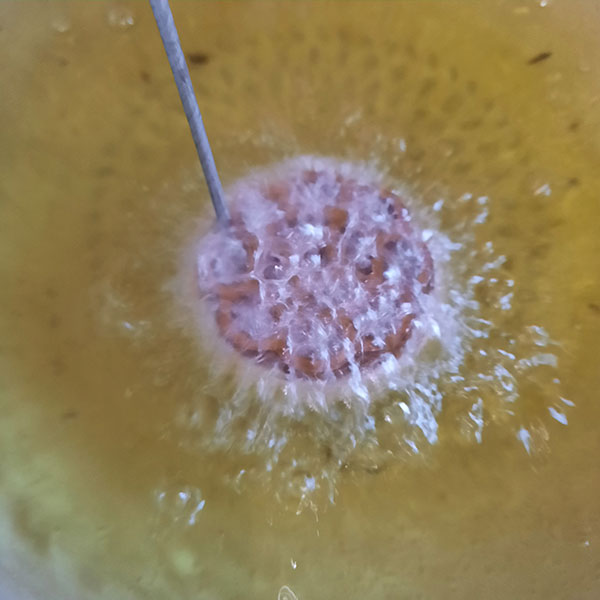

Ingredients
As mentioned above, we only need a few ingredients for homemade kuih rose.
Rice Flour
Kuih rose is a rice flour cookie. So you absolutely must have that at hand. The type of rice flour you want is a simple jasmine rice flour, not glutinous or sticky rice flour. You will be able to find this easily in any Asian store, whether Indian/Pakistani or East Asian.
You can also find it in our supermarkets here in the UK, in the gluten free baking collection. This is the one I’m currently using that you can find on Amazon (affiliate link), but I purchased it from my local Pakistani grocer.
Egg
There are huge discrepancies in egg sizes. What passes off as large in one country (or farm) is medium in another. So, I’ve given a rough weight for the egg before you crack it, as I think it’s more user friendly that way. The egg shell weight is fairly negligible.
But don’t sweat it if your egg is slightly heavier or lighter. Making kuih rose is not an exact science, there is a lot of room for negotiation!
Can you use duck eggs to make kuih rose? Absolutely!
Sugar and Salt
We use white caster or granulated sugar to make kuih loyang. Once again, the cook’s preference comes into play here. I probably use a little more sugar than most people, as I like these cookies that way, as do my kids. But they are still only slightly sweet.
I’ve also used golden caster sugar to make kuih rose, giving a sweeter and darker cookie.
A pinch of salt rounds off the flavour of the cookie nicely, as it does with most baked goods.
Oil for Frying
We want a flavourless oil for frying our kuih rose. Anything that you use, whatever brand, works fine. I tend to use a flavourless vegetable oil like rapeseed or corn oil.
Kuih Rose Mould
The kuih rose mould should be very easy to get. This is because as mentioned above, these cookies are found all around the world.
Just do a search for “rosette cookie mould” or “kuih rose mould”, and you should have lots of options. The pattern will vary, take your pick.
Here’s an image of what it looks like.

Flavourings
Traditionally, kuih rose isn’t flavoured. It has a creamy, almost vanilla flavour to it, cooked as it is. However, if you like, you can flavour your kuih loyang.
The most obvious flavouring here would be pandan leaves, which have a natural affinity with coconut milk.
Just place your coconut milk in a small food chopper or blender. Take a pair of scissors and cut 2 pandan leaves straight into the chopper. Chop everything up to release the pandan essence and colour into the coconut milk.
Then strain this flavoured and coloured coconut milk straight into the egg and sugar mix, after step 1 in the recipe.
Besides pandan, you can also use vanilla, which will enhance that creamy flavour I talked about above.
I also make the Persian version of rosette cookies called nan panjerei. In that, we use rose water. So rose water and orange blossom water are my 2 other favourite kuih rose flavourings. I’ll link that up as soon as the article is live!
Tips
1. Get everything ready and work fast. Kuih rose cook very quickly. It’s a very thin line between just right and burnt. So make sure that you have everything ready at hand: the utensils, plate, kitchen paper, spatula, etc.
2. Heat your mould before every dip. You mould needs to be hot enough for the batter to cling to it.
3. Shake excess oil off again and again before dipping the mould into the batter. Too much oil and your batter will just glide off, and you don’t want that either. In fact, I have a kitchen paper at hand to dab (tap, tap, not wipe) excess oil off the mould.

4. Remove your cooked kuih rose when it’s still a light golden colour. It will continue to brown for a few seconds after being lifted out of the oil. Don’t worry if you burn the first couple. Or 10! Practice makes perfect.
5. Stir your batter before every dip. This is important. Everytime you dip your mould in the batter, you will drop a smidgen of oil in. So we stir to smooth out the batter.
6. Fry just 2 cookies at a time, maybe 3, if you are not an expert at this. This will allow you to get to those cooked cookies before they burn.
7. Use a flat spatula to lift your kuih rose out as it will still be soft and will curve up, following the shape of whatever you are using. It starts hardening within seconds of being lifted out of the hot oil, so keep it flat.
8. If your kuih rose is stuck to the mould, use a wooden chopstick to push it through the holes in the mould.
9. How to know if your oil is hot enough? Dip any wooden utensil in the hot oil (wooden spoon, spatula, chopstick). If you see bubbles gathering against the utensil, it’s hot enough. No need to drop any batter in.

How to Store?
Once your kuih rose are all done, let them cool to room temperature. Then store them in an airtight container, away from direct sunlight (they’ll sweat otherwise).
Kuih rose will last a good 2 weeks. You can go 3 weeks, but I think they are best in the first 2.
And now, shall we get cooking?
If you enjoy the recipe, drop me a comment and let me know. And if you are feeling like a star, don’t forget that 5-star rating!
If you make this recipe, post it on Instagram and tag me @azlinbloor and hashtag it #linsfood.
Lin xx
More Festive Cookies
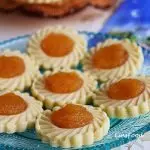
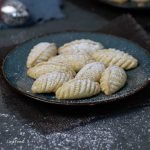
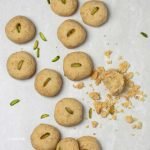

Kuih Rose (aka Kuih Loyang, Rosette Cookies)
Equipment
- 1 large bowl
- 1 whish or fork
- weighing scales
- small bowls as needed for weighing
- 1 wok or small saucepan
- 1 flat spatula
- kitchen paper
- large plate
- container for storing
Ingredients
- 1 large egg (about 60g/2.1 oz weight, including shell)
- 70 g white sugar
- 80 ml coconut milk
- 120 g rice flour
- 1 pinch salt
- 500 ml vegetable oil you need enough for the oil to come up about 5cm/2 inches high. This will depend on how wide your wok or saucepan is.
Instructions
- Whisk the egg and sugar for 30 sec, with a manual whisk or fork.

- Add the coconut milk and whisk lightly to mix.
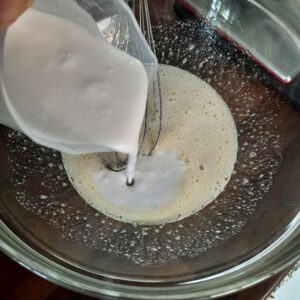
- Tip in the flour and lightly whisk in to mix well. Leave to rest for 10 minutes. There is no need to strain your batter. Any tiny lump will fall apart in those 10 minutes. Stir before using.
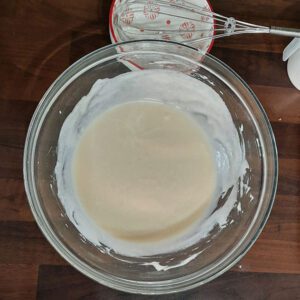
- Heat your oil on medium heat until hot. To know if your oil is hot enough, just dip in any wooden utensil (spatula, chopstick). If tiny bubbles appear, it's hot enough.Place your kuih rose mould in the hot oil for 10 seconds to heat up.

- Give it a good shake to get rid of excess oil, then dip your mould into the batter to cover the sides of the mould but leaving the top batter free.
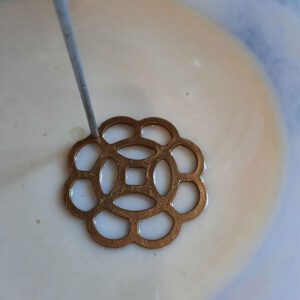
- Transfer your batter covered mould into the hot oil, fully submerging it. Hold for 10 seconds, then give a gentle shake to dislodge the kuih ros.Repeat with a second cookie.

- By the time you've dislodged the second one, the first cookie will be done. Scoop it out with a flat spatula and place it on a plate lined with kitchen paper.Repeat until all the batter is done. Cool the cookies completely, then store in an airtight container. Will keep for 3 weeks, but best in the first 2.


These turned out amazing. Thank you so much, your step by step photos were very helpful!
My pleasure, Sara, I’m pleased to hear that.